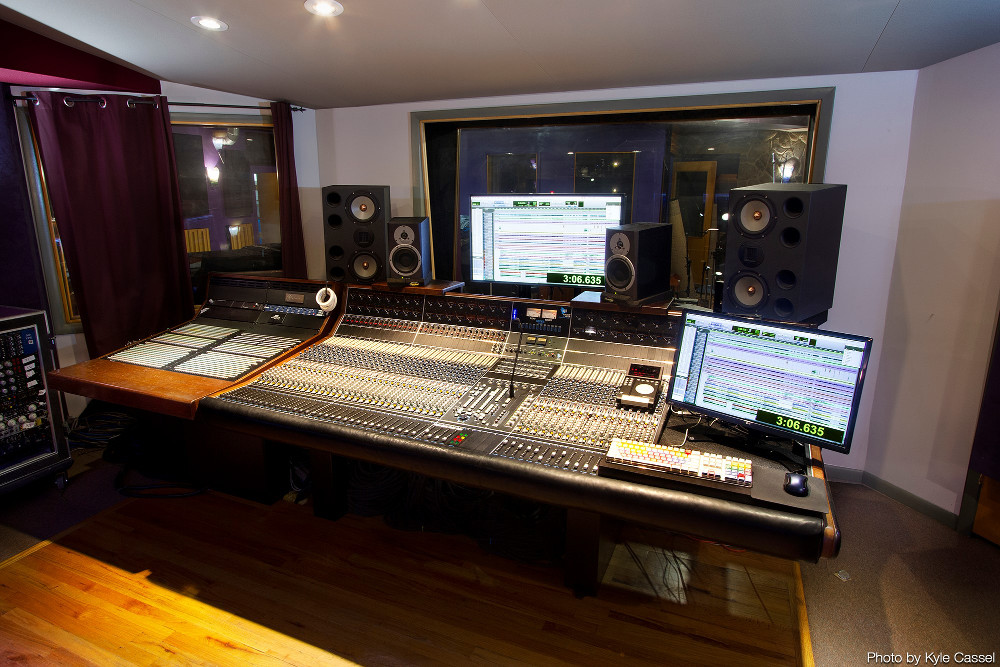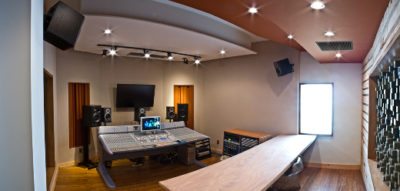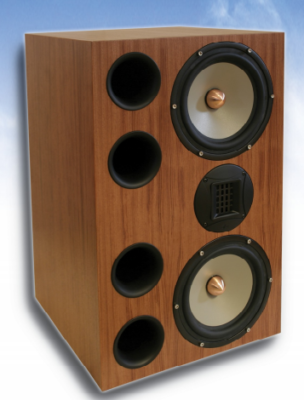Monitor Switch: How an API Studio Reimagined Its Midfields
Evaluating and re-evaluating monitors is a constant process at studios. Whether for a personal studio or commercial facility, producers and audio engineers should be constantly checking in on their monitoring choices.
Kaleidoscope Sound in Union City, NJ experienced such an evolution at it’s Studio A, a renowned room equipped with a 48-channel API Legacy Plus analog console. It’s also got a 600 square foot live room, a 1909 Steinway B piano, huge mic locker, plus a lot of instruments and analog gear.
Founder Randy Crafton told SonicScoop, “We believe that we have hit a nice stride as a studio. Tom Beaujour is firmly ensconced in the Patio Studio, and we have consolidated a lot of gear into our Studio A. We have a great roster of engineers that call this room home, including Kyle Cassel (Kaleidoscope alum, now independent), Wayne Dorell (of the Pigeon Club), Chris Parks, Nick Saya, and of course, the one and only John Agnello—check out his Gear Club podcast. In addition, our own Jeremy Delaney has become John’s right hand guy, and he has gotten really, really good under his guidance.
“One by one, all of these guys are slowly coming back to life post-covid,” Crafton continues, “and starting to work in the studio again. Let us hope that we can continue to get back to a time when scheduling and amp choices are the things that keep us up at night.”
A frequent collaborator of Crafton’s, the prolific studio designer Fran Manzella continues to newly reveal his sonic fingerprint in audio facilities, even after his passing. In this case, his Griffin Audio G2B midfield monitors led Kaleidoscope to be the site of our latest “Studio Monitor Switch” article series. Crafton walked us through the thought process and action items.

Kaleidoscope Studios Studio A, with its 48-channel API and Griffin Audio G2B midfield monitors. (Photo credit: Kyle Cassel)
Phase One: Moving On
Prior to the switch, Randy Crafton and his crew had a squad of highly capable monitoring systems in Kaleidoscope’s Studio A. These were headed up by a pair of Dynaudio BM15a large near field monitors, and joined by a variety of small speakers including Yamaha NS10’s and Dynaudio BM5a near fields.
“In hindsight, the greatest strength of the 15a’s was my familiarity with them,” Crafton says. “When Fran re-built the room for me in 2009, I decided to stick with the Dynaudios because everything else was changing, and I felt I needed a constant. That is when we installed the API Legacy-plus, and we completely gutted the control room of A and re-built. The improvement in the sound was immense—it was largely just my best guesses up until that point.
“The Dyns sounded better than they ever had,” Crafton continues, “and despite Fran trying to convince me that these Griffin’s would be perfect for the room as it was, I resisted. He did not—as usual—do a hard sell, and I was pretty tapped out from the console, the rebuild and the downtime. That’s the long/short story of how the Dynaudio BM15A’s remained in the room.”
Phase Two: Picking a Pair
The Dynaudio BM15A’s seemed set. But Crafton kept the Griffins in mind, and eventually seized on a project originating in the Big Easy as an ideal test for Manzella’s monitors.
The timeline for Crafton’s thought process dates back to 2012, when Kaleidoscope had completed work on its “Patio” studio. “It was designed from the bottom up by Fran, and it was the most reliable mix room any of us had ever worked in,” says Crafton. “We got to the point where none of us wanted to mix in A, because the Patio was so great.”
Then in 2019, engineer Tom Beaujour of Hoboken’s Nuthouse Recording set up shop in the Patio. Kaleidoscope’s team realized they would have to revisit mixing in Studio A. “We tried a variety of speakers, and then I contacted Fran about trying some Griffins,” Crafton relates. “It was almost like he had been waiting patiently for me to come around. I was heading into a mix on a Lulu and the Broadsides (w/Dayna Kurtz) project with Ray Dillard coming down from Canada to work with me. We had tracked it together in New Orleans, and wanted to mix it together.
“I thought this would be a good opportunity to try out the Griffins, and Fran was willing to loan me a pair to audition on this project. From the moment we installed and listened, there was zero chance he was getting them back. We had not even placed them carefully, tuned them, or anything, and it was a whole different ball game mixing in there.”
Phase Three: Planning the Install
As careful as Crafton is about many things, Kaleidoscope’s installation of the Griffin Audio shows that sometimes it’s OK for studios to simply shoot from the hip.
“We pretty much just went for it,” Crafton explains. “It was right before Covid hit, and we were going great guns. We didn’t have much time on our hands, so we basically took the Dynaudio BM15A’s off the stand, put up the Griffins—after trying a variety of other speakers—hit ‘play,’ and were smiling.
“By the time we were done with the Lulu and the Broadsides mix, Covid was beginning to become a reality. Fran was exercising great caution and put off coming out to ‘tune and tweak’ until things felt safer. He talked me through a number of things to try and consider. We were, and continue to be, so satisfied, that there was no point in pressuring him.”
Phase Four: Tuning In
There was a reason that Kaleidoscope was able to get away with not having an official tuning session right away. “Basically, Fran built the room with these speakers in mind, and we just finally put them in place,” says Crafton. “It was seamless. The only really odd adventure was not an acoustical one.”
What unfolded next proves that you never know how your past studio experiences might contribute to troubleshooting. “Around the time of the speaker install, our Uptown automation on the API stopped working,” Crafton recalls. “We were perplexed, since as primitive as it is, it had always been rock solid. Finally, in frustration, Jeremy deduced that it stopped working around the time of the new speakers. We unplugged the speakers from the console, and…the automation came back.
“I talked to Fran, our tech, Ricky Begin, and none of us could imagine why there would be any relationship. Jeremy plugged them back in, automation stopped working. I finally suggested that he put a ground lift on the speakers—for no reason at all, except it sometimes helps weird things. It worked! Speakers were still quiet, and automation happy. To this day, none of us have any idea what the relationship could possibly be.”
At this point, however, Kaleidoscope’s Griffin switch took a tragic turn. “I had been in touch with Fran at least once a week, and sometimes every few days during the peak of the Covid shutdown,” says Crafton. “We were in touch about the speakers, the install, etc., but also just touching base as friends supporting each other through a very strange time. We have both seen a lot of crazy in our work in the industry, but this was a new level of worldwide crazy. We were growing to enjoy venting about the trends in the world to one another, exchanging tales from the trenches, expressing thoughts that were not fit for social media about the state of the country, and generally helping each other keep our humor and sanity through insane times.
“I knew he was going in for a routine hip replacement, and I saw a photo on Facebook with a thumbs up from a hospital bed. Seemed routine enough. Then, like many, I got the terrible and unbelievable news of his passing, from social media. It was a crushing blow, in the midst of uncertain times. I felt awful for his family, but did not know them personally, so I felt awkward reaching out. Like so many of his friends and colleagues, I just sat alone in a room that he had created for me, feeling nostalgic, deeply sad, humbled, and needing to get some work done.”
Beyond being his studio designer and speaker creator, Crafton realized that Manzella had become an invaluable resource for him – in audio and far beyond. “I learned a lot from Fran,” Crafton reflects. “Sure, I learned some things about acoustics, design of workflow in spaces, not to put the door to the control in the front where it affects the monitoring when it is frequently left open, what gear to keep in the sweet spot, and what to put on the edges and out of way places.
“But I mostly took away lessons about maintaining humor in the face of the unknowable, coming to peace with compromises since everything he did was about balancing necessary tradeoffs and compromises, treating people well while maintaining professional boundaries, and taking joy in things that aren’t work-related, at times.
“I am supported by Fran every time I sit down in my studio to work, but I sure do miss the conversations, jokes, and bottomless well of knowledge and experience that he shared so willingly. It always felt like I had a secret weapon available to solve problems.”
Phase Five: Critical Listening Luv
True to the vision of everyone involved, an official room tuning is coming up for Kaleidoscope. According to Crafton, the full reopening of travel will bring Lars Tofastrud, the Europe-based builder/designer of the Griffin speakers and Manzella’s longtime partner, to Union City for a thorough tune ‘n’ tweak.
“Meanwhile, we are very happy campers, and everyone who has worked with them is thrilled,” Crafton notes. “The room is very true, and requires no speaker switching, car listening, taking home, etc… to figure out the mix. The Griffin G2B Midfields are revealing, but not fatiguing. If the low end sounds right, it is right. If the vocal level sounds right, it is right. If the reverb sounds too long, it is too long. It really eliminates the guess work, and as always, the art of the decision falls where it belongs, squarely on the shoulders of the engineer’s ears, experience, and levels of sonic and musical awareness.
“At the end of the day, speakers, rooms, consoles, mics, computers, are all just tools to allow us to capture magic. If they do their part, and everyone else does their part, it is magic in a bottle—well, on a hard drive! Isn’t that this is all about, anyway?”
— David Weiss is an Editor for SonicScoop.com, and has been covering pro audio developments for over 20 years. He is also the co-author of the music industry’s leading textbook on synch licensing, “Music Supervision, 2nd Edition: The Complete Guide to Selecting Music for Movies, TV, Games & New Media.” Email: david@sonicscoop.com
Please note: When you buy products through links on this page, we may earn an affiliate commission.









[…] Kaleidoscope Sound in Union City, NJ experienced evolution at it’s Studio A, a renowned room equipped with a 48-channel Read more… […]
[…] Kaleidoscope Sound in Union City, NJ experienced such an evolution at it’s Studio A, a renowned room equipped with Read more… […]